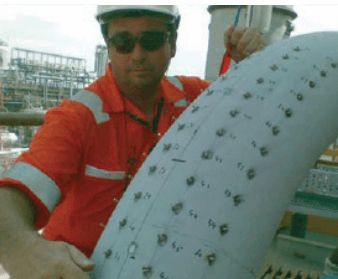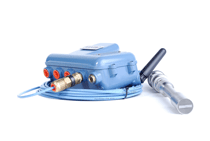As oil and gas flow through pipes and processing facilities, so do other elements which contribute to corrosion. Effectively managing this corrosion is critical to ongoing safety, reliability, and efficient operation.
In a recent Society of Petroleum Engineers (SPE) Global Integrated Workshop Series in Malaysia, Emerson’s Jyotsna Joshi presented, Putting in Place An Effective Corrosion Monitoring Program – Meeting Recent Developments, The Rise of Wireless & Combining Different Technologies Into One. In her presentation, Jyotsna explored corrosion and sand erosion challenges in the oil and gas production industry and actions help mitigate these challenges.There are a range of corrosion and erosion issues faced both by the upstream and downstream oil and gas industry. As producing fields age, the water cut in the produced fluids increases. This increase coupled with more sand production leads to increased corrosion and erosion. Also where hydrogen sulfide (H2S) is present, it is an additional source of corrosion. Also, as the gas/oil ratio (GOR) increases, so does the fluid flow velocities which increases the effect of erosion caused by sand particles in the produced fluid.
Downstream in refineries, as refiners look to improve margins through lower cost “opportunity crudes”, these crudes may contain high total acid number (TAN) which can lead to high temperature naphthenic acid corrosion (NAC) causing reliability issues in crude feedstock heaters, furnaces, transfer lines, feed and reflux sections of distillation columns, atmospheric and vacuum columns, and heat exchangers and condensers.
Jyotsna outlined several ways producers and refiners are addressing these corrosion challenges:
- Optimizing dosing injection of chemical corrosion inhibitors
- Adjusting flow rates
- Correlating with other parameters (e.g. oxygen in injection water systems)
- Monitoring corrosion rate of change
- Adding reliable measurements to perform continuous monitoring
For offshore production platforms, it’s important to protect the assets by detecting increased corrosion and erosion before damage is caused. It is also important to verify the effect of the corrosion and erosion control measures. Piping and vessel wall thicknesses at selected locations need to be measured periodically and be a source of input for risk-based inspection planning. This combination of monitoring and inspection activities is part of the overall integrity management process.
Sand production is often an increasing challenge as a field grows older. The risk of sand production normally increase with production rates. In order to avoid the risk of sand production, production rates are normally limited to an amount where sand is not produced or sand is produced in acceptable amounts. Limiting production cause a production loss. Sand and sand/erosion monitoring is often used to find the optimized production rates (e.g. maximum sand free rates), which can easily give a significant added production value of each well.
The result of sand production can be erosion damage, with equipment failures and repairs as a consequence. As a worst case, production wells could be lost if sand production is not controlled. Sand production can start and increase rapidly, and can cause significant damage in a short time. As a worst case, sand can cause leaks and uncontrolled release of hydrocarbons, which can be a direct danger for the safety of the production site. It could also be mentioned that stainless steel piping often is constructed without allowance for metal loss. Hence, erosion damage can result in wall thicknesses compromising with design criteria.
Finally, sand production can have negative environmental effect, both due to the produced sand, but also due to possible spills of hydrocarbons as a result of leaks. Since sand production can change rapidly, it is recommended that sand monitoring be continuous and on-line and work as one of the important tools in production optimization.
Jyotsna shared some corrosion monitoring applications. For fast response with intrusive probes, Electrical Resistance (ER) and Linear Polarisation Resistance (LPR) probes can be used. ER probes measure corrosion rates as an increase in electrical resistance over time for a steel element in the probe face and may be used in all relevant environments, such as oil, water and gas.
LPR probes requires a conductive electrolyte, and will give corrosion rates immediately and are therefore recommended for water systems, oil systems with high and continuous water cuts, and for detection of corrosion due to condensation of water. When connected to wired or wireless transmitters, these measurement devices provide accurate online monitoring of sand, corrosion and inhibitor injection control.
Sensing pin matrix with pin number identification
installed for FSMLog installation for high
temperature monitoring in a refinery.
By providing continuous online corrosion monitoring, reliable trend analysis based on larger data samples can be established. This improves verification prior to corrective actions being performed. These measurements can also signal process and external environment changes that need to be investigated. And changing rates can trigger real-time alarms to have operations and maintenance personnel take action.
Ultimately, this leads to safer, more reliable and efficient operations and fully integrated with existing process automation systems.
You can connect and interact with other oil & gas and refining professionals in the Oil & Gas and Refining groups in the Emerson Exchange 365 community.
Update: I wanted to share this exchange in my LinkedIn status to raise its visibility:
Very interesting. I recognize some of the problems from my years in the district heating industry. You do not mention vortex erosion; if you have not seen it, you will be surprised how much damage that can cause, and how fast.
I responded:
Thanks for sharing your thoughts. I did some search around and found some info on vortex erosion https://jimc.me/1dkieY6. They indicated that erosion is indeed greater. The good news is that Field Signature Method (FSM) mentioned in the post can alert on this type of erosion condition.
Jyotsna described an approach to combat vortex erosion:
Depending on criticality of the situation multiple solutions can be used for sand detection which mainly causes erosion in the pipelines. We usually recommend to use for Acoustic base and intrusive sand detectors both as both technology complements each other and operators can get early detection of sand production. We would like to know more about the applications where you have seen Vortex Erosion. Thanks once again.






